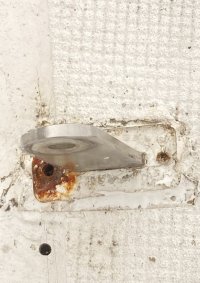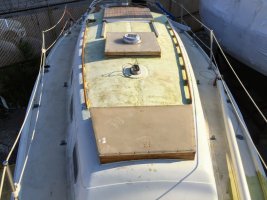I have attached a picture of the moisture reading from the portside decking near the chainplate. I have also attached a picture after removing the bedding plate. My instinct (Option 1) is to open up the decking by removing the deck skin, clear out the soaked balsa core, dry out, reglass/epoxy, install new balsa core and replace the skin with over reglassing using chopstrand and biaxial matt glass secured with fairing compound. I would rebed the chainplate and bedding plate with butyl tape instead of chaulk that has been used in the past. I'm sure the balsa core is 50 years old like the boat. This is my first thought.
My second thought (Option 2) is what was told to me by the boatyard. They suggest removing all the caulk, clean the plates, fill the holes with epoxy and rebed with butyl tape.
My concern is that if I do option #1, I may upset the stability of the chainplate. The problem I see for option #2 is that I may be just putting off a serious problem that may raise it's ugly head later.
Looking for any opinions as to which is the best option based on anyone's experience. I do have experience with the process of replacing old decking. I rebuilt the cabin top by the process above in option 1 but the cabin top doesn't have the tension on it like a chainplate does.
Let me know your thoughts.
My second thought (Option 2) is what was told to me by the boatyard. They suggest removing all the caulk, clean the plates, fill the holes with epoxy and rebed with butyl tape.
My concern is that if I do option #1, I may upset the stability of the chainplate. The problem I see for option #2 is that I may be just putting off a serious problem that may raise it's ugly head later.
Looking for any opinions as to which is the best option based on anyone's experience. I do have experience with the process of replacing old decking. I rebuilt the cabin top by the process above in option 1 but the cabin top doesn't have the tension on it like a chainplate does.
Let me know your thoughts.


